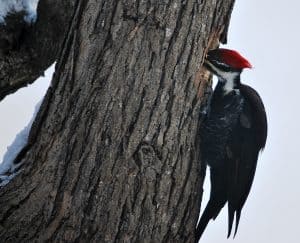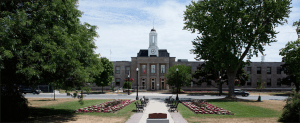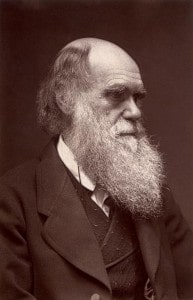February 12 is a day to reflect on the principles of perpetual curiosity, scientific thinking, and hunger for truth as embodied in Charles Darwin.
With the arrival of February – a time I like to call ‘pre-spring’ – bird sound is slowly returning to the natural world. A week ago, I heard the boisterous song of the cardinal for the first time since last summer. Our neighbourhood Downy and Hairy Woodpeckers are making their presence known, too, as they drum against resonant tree trunks to advertize ownership of territory and to renew or establish pair bonds. Whenever I hear this hammering, I can’t help but wonder how their brains have adapted to endure a lifetime of head-banging at such incredible forces of acceleration. Humans suffer concussions at forces ten times smaller.
However, thanks to Charles Darwin’s theory of evolution, science has a powerful tool with which to investigate this question. In the 25 million years that woodpeckers have been on this planet, their bodies have undergone a continual process of evolutionary adaptation. There have been changes in the beak, the neck muscles, the skull and even at the level of certain proteins. Recent research has shown that woodpecker brains have high levels of a protein called ‘tau’, which is also present in the brains of humans who have suffered brain damage or neurodegenerative disease. Scientists are learning that some kinds of ‘tau’ are protective, while others can become toxic. Do woodpeckers have the protective form and therefore don’t suffer neurological repercussions? Learning more about woodpecker tau may be highly useful some day in treating concussions and neurodegenerative disorders in humans. This is just one example of how the theory of evolution is routinely used to figure out where to look for potential cures. Without his discovery of natural selection – the process whereby organisms better adapted to their environment tend to survive and produce more offspring – the greatest achievements in medicine and human well-being over the past two hundred years would have been impossible.
Time scale
Part of the difficulty in understanding evolution is our inability to grasp the staggering amount of time it has had to work with. Our brains have evolved to understand time on the scale of decades and centuries at most. The idea that life has been evolving for over three billion years is therefore quite impossible to grasp. To make this time-span a little more tangible, let’s imagine it as a 4.6 kilometre walk, starting at the Disc Golf Course at the north end of Riverview Zoo and ending at City Hall in downtown Peterborough. The starting point represents the moment in time 4.6 billion years ago when planet Earth was created from a nebula cloud of gas and dust. The end point represents the present day. As we walk along the route, we’ll point out the moments in time when key events in evolution occurred. At this scale, each step represents about 700,000 years. (Note: BYA = billion years old and MYA = million years ago)
For the first kilometre, Earth is devoid of living things. You see little more than a scalding rock with choking fumes. However, as we pass the zoo’s miniature train station and the fighter aircraft on display (3, 5 BYA), the first life appears in oceans. At Marina Boulevard (3.25 BYA), life evolves the ability to capture the sun’s energy through photosynthesis. Twelve minutes of walking later, at Anson Street (1.9 BYA), the first cells with nuclei have evolved, but it’s not until we arrive at Locks Salon & Spa, just south of George Street (650 MYA) that multi-cellular organisms emerge. Having mastered the cell, evolution can now start moving faster. At Edinburgh Street by Amusé Coffee (500 MYA), the first land plants show up and at London Street (245 MYA), the age of the dinosaurs begins. Then, as we pass in front of the former George Street United Church (200 MYA), the first mammals arrive on the scene. Having crossed McDonnel Street, a mass extinction at 65 MYA event wipes out all of the dinosaurs, but not the branch that went on to become birds such as woodpeckers. However, it’s only when we arrive at the bottom of the steps at City Hall (3.5 MYA) that the first proto-humans appear. At this point, we’ll need to get out our tape measure. At a mere 10 cm from the main doors, evolution produces Homo sapiens, our own species. But it’s only in the last centimetre – 10,000 years ago – that recorded human history begins, and only in the last one-fifth of a millimetre that we enter the Industrial Revolution and present-day times. Now, take a moment to reflect back on how far we’ve walked – and all the time that evolution has had to produce a species that can reflect on its own origins!
Darwin Day
Charles Darwin was born in Shrewsbury, England, on February 12 1809. Ever since he published his radically insightful book, On the Origin of Species, Darwin has been the focus of commemorations and tributes by scientists, artists and scholars. The 200th anniversary of his birth in 2009 saw an entire season of BBC programming on Charles Darwin himself as well as evolution and natural selection. Since then, Darwin Day events have been organized each February throughout the world.
The purpose of Darwin Day is to promote Darwin’s contribution to science and to call attention to the importance of science in general. According to the International Darwin Day website, the day “will inspire people throughout the globe to reflect and act on the principles of intellectual bravery, perpetual curiosity, scientific thinking and hunger for truth as embodied by Charles Darwin.” Science is our most reliable knowledge system and has provided enormous benefit to the health, prosperity and intellectual satisfaction for our human existence. These are worthy achievements for all people to celebrate. This is especially important given that some people, including the U.S. government, appear unconcerned by scientifically-proven threats to civilization such as climate change.
Get informed
A great way to celebrate Darwin Day is to become more informed about evolution yourself. Make a point of talking about it with your children and grandchildren. If you are a teacher, consider organizing some Darwin Day activities. Your students would love a classroom science celebration.
Darwinday.org provides wonderful resources for becoming more informed about Darwin himself and his theory of evolution. They include six websites, four books for children, eight books for adults, six videos, four documentaries and two dramas. I especially enjoyed looking at “Darwin’s Diary”, which delves into Darwin’s life and work through an interactive diary created for PBS’ program, Evolution. The “Understanding Evolution” website is also excellent. This “one-stop website for information on evolution” provides an in-depth course on the science of evolution as well as superb teaching materials for grades K-2 all the way to 9-12. You will also find a fascinating article on how backyard birdfeeders in the U.K. appear to be driving the evolution of longer beaks in Great Tits, a type of chickadee. If you’re interested in fish, I’d also recommend checking out “A fisheye view of the tree of life”. This interactive evolutionary tree highlights some of the amazing innovations that have evolved in the different lineages of fish.
The annual Darwin Day Lecture will also be taking place at the Royal Ontario Museum on February 13 from 7:00 -8:00 pm. It is entitled “How do Tardigrades Survive Everything?”
Discovered in 1773, tardigrades, also known as “water bears,” are found everywhere on Earth. Dr. Thomas Boothby, from the University of North Carolina, will explain how evolution has equipped these micro-animals to survive the most extreme environments imaginable, including outer space. Call 416-586-5797 for more information.
Vancouver Resolution
The Darwin Day Foundation believes it’s time for a global celebration of science and humanity. To this end, they have introduced Darwin Day Resolutions to the U.S. House and Senate and in various states. Cities, such as San Diego, Omaha, Regina and Vancouver have also passed Darwin Day resolutions. The text of the Vancouver Resolution reads as follows:
WHERAS February 12, 2013 is the anniversary of the birth of Charles Darwin in 1809; AND WHEREAS Charles Darwin is recognized for the development of the theory of evolution by the mechanism of natural selection; AND WHEREAS Darwin’s theory of evolution by natural selection is recognized as the foundation of modern biology, an essential tool in understanding the natural world and the development of life on earth; AND WHEREAS Darwin’s theory of evolution by natural selection has provided, and continues to provide, the basis for great advances in science, medicine, and philosophy; AND WHEREAS The anniversary of Darwin’s birthday is an appropriate period on which to reflect and celebrate the importance of scientific advancement to all people; AND WHEREAS The City of Vancouver is rightfully proud of its commitment to scientifically-based environmental awareness, appropriate technology, and progressive education: NOW, THEREFORE, I, Gregor Robertson, Mayor of the City of Vancouver, DO HEREBY PROCLAIM February 12, 2013 as “INTERNATIONAL DARWIN DAY” in the City of Vancouver. Let’s encourage Peterborough City Council to pass a similar resolution next year!
Finally, the next time you hear a woodpecker drumming, pause for a moment to thank Charles Darwin for making sense of what’s going on – and why the bird isn’t suffering from a splitting headache!


